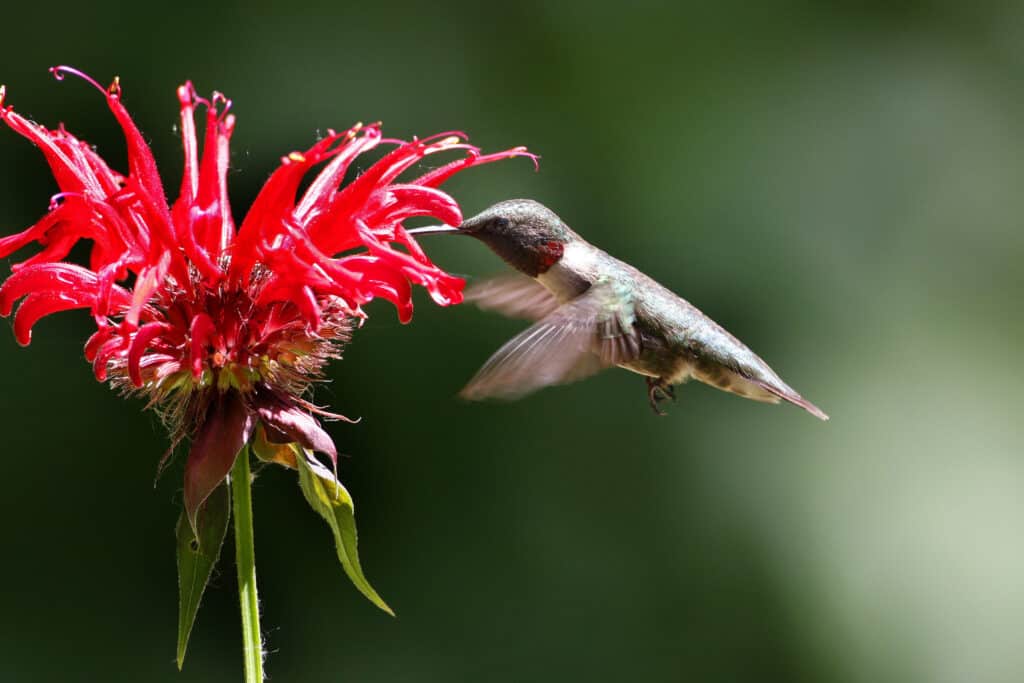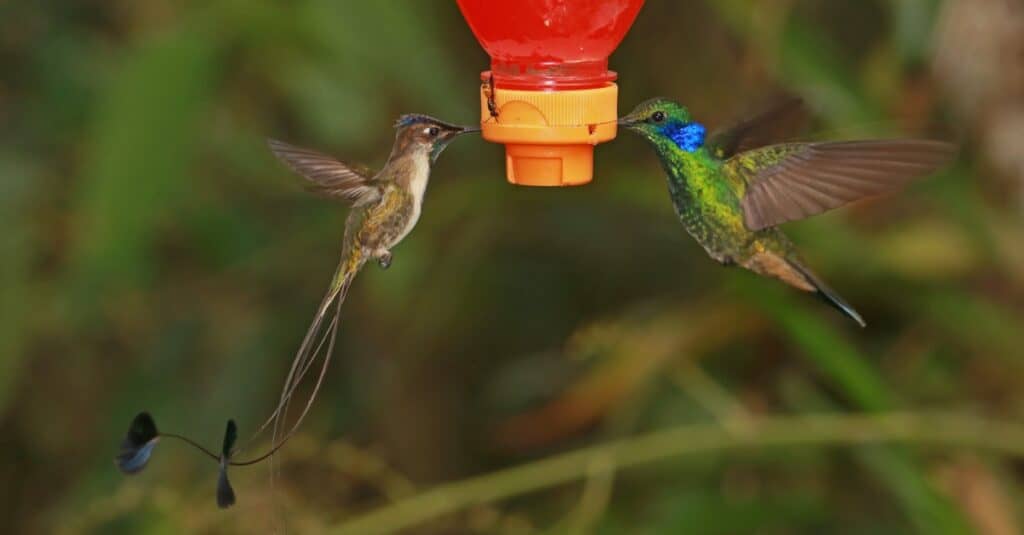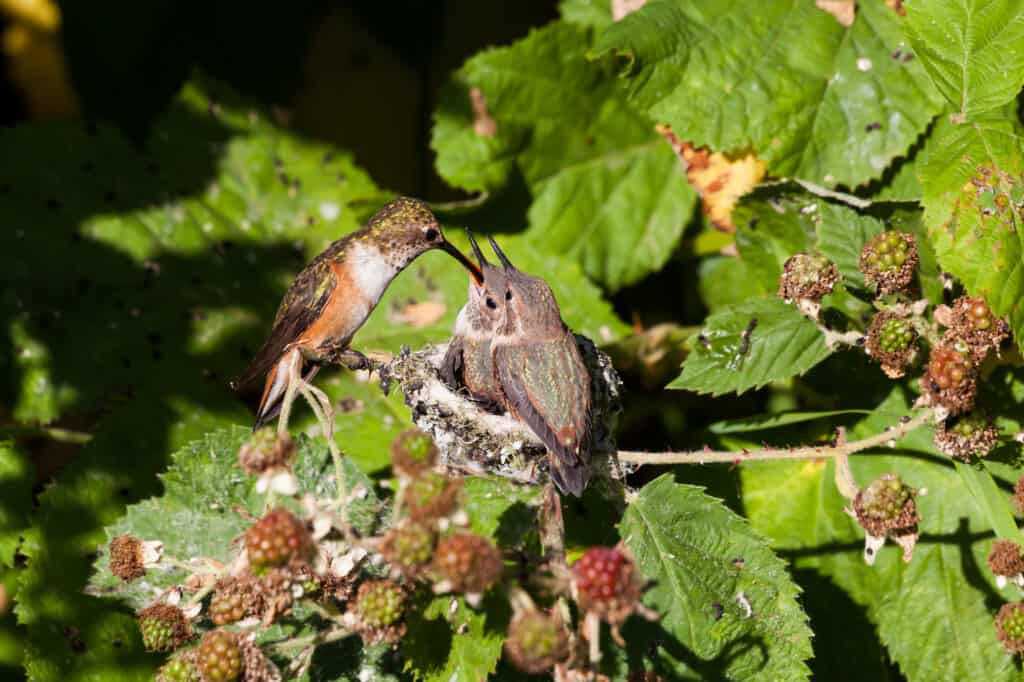The Trochilidae family of hummingbirds, which has a record 366 species and only inhabits the Americas, are renowned for their delicate flying ability and brilliantly colorful plumage. There are many different species in that wide range, but what is the name of a grouping of hummingbirds?
A charm is the most typical collective term for a group of hummingbirds, which is a fitting name given their diminutive size. A shimmer and a bouquet of hummingbirds are two more common examples of names for multiple hummingbirds.
Hummingbird Charms: Family and Friends

While hummingbirds are particularly solitary, groups of them are called charms.
©Agnieszka Bacal/Shutterstock.com
Although there are over 366 species of hummingbirds, the overwhelming, vast majority only ever join flocks for a brief period of time when feeding.
Hummingbirds are independent and aggressively chase away rival hummingbirds who feed in their region. Several hummingbirds can still get food from the same spot.
Hummingbirds are solitary creatures, even during the breeding season. For instance, during their brief courtship period, which lasts only a few minutes, the ruby-throated and calliope hummingbirds only briefly interact with one another.
Why Are Hummingbirds Solitary?

Birds tend to be more solitary likely for the autonomy it provides.
©Chris Alcock/Shutterstock.com
Several bird species, such as snipes, flycatchers, warblers, and robins, live alone. A benefit of solitary behavior is that each bird can choose its own autonomous course of action without joining the flock when choosing food and breeding locations.
Given that the male can mate with numerous females throughout the breeding season, one of the main reasons hummingbirds developed solitary behavior is probably to maximize the likelihood of successful breeding. Given the very brief lifespan of these little birds, the reduced egg clutch sizes are probably a benefit.
Charms During Migration

Calliope hummingbirds migrate fairly large distances, sometimes from as far north as Canada to as far south as Mexico.
©MTKhaled mahmud/Shutterstock.com
Several hummingbird species are highly migratory, which frequently comes as a surprise given their small size and little wings. Throughout the winter, the calliope hummingbird migrates from as far north as Canada to as far south as Mexico and Central America, reaching only three inches long and being the tiniest and lightest mammal to do so.
Another species that migrate a great distance from its nesting sites to its wintering habitats in Central America is the black-chinned hummingbird. A comparable 2,000-mile journey across the Rocky Mountains is made by the rufous hummingbird from its farthest northern breeding sites in Alaska.
The fact that hummingbirds make all of these migratory trips by themselves makes them very interesting. Hummingbirds have an innate capacity to migrate unaccompanied; they do not appear to learn their travels from observing others of their kind, much to the surprise of scientists. They don’t always travel by themselves, though; occasionally, they migrate with other, larger birds.
How Many Hummingbirds Live in the Average Charm?

It’s rare to see hummingbirds of different nests feeding together in the same place without driving each other away.
©iStock.com/neil bowman
Hummingbirds occasionally congregate around garden bird feeders as well as in their food-rich tropical and rainforest habitats. There was even a video captured in Ecuador that shows a sizable group of hummingbirds dining simultaneously.
If you manage to observe several hummingbirds with each other without one driving the other away for any length of time, you’re extremely fortunate. Having said that, some do succeed in luring numerous hummingbirds to their gardens, frequently a mix of species.
What Do You Call a Pair of Hummingbirds?

Since hummingbirds are polygamous and males spend very little time with female mates, there is no name for a pair of hummingbirds.
©Feng Yu/Shutterstock.com
A pair of hummingbirds has no particular name. Hummingbirds are polygamous, with the male frequently just spending the minimum necessary amount of time with the female, who then carries all responsibilities for the nest and its upkeep.
Males and females both have solitary, possessive lives and are frequently hostile toward one another as well as other small creatures or bugs that share their territory.
It’s important to note that because hummingbirds are small, reclusive birds who reside far inside their dense habits, their behavior is little understood in many species. Therefore, it’s quite unlikely that any hummingbird species is even slightly monogamous.
Fun Facts About Hummingbirds

The red-dyed hummingbird nectar you can buy in stores is bad for hummingbirds. To attract them, use a red feeder and clear nectar instead.
©Rick Scuteri/Shutterstock.com
Hummingbirds lack an olfactory sense. Despite not being able to detect feeders, they have excellent color vision. Orange or red flowers are preferred by some birds, such as the ruby-throated hummingbird. Red dye, though, shouldn’t be added to nectar because it can hurt the birds. Grow red or orange flowers instead, or utilize feeders with red coloring on the framework.
The name “hummingbird” refers to the humming sound that a hummingbird’s rapidly beating wings generate.
Only hummingbirds are capable of flying backward. Hummingbirds move their tongues in and out roughly 13 times per second as they consume the nectar from feeders. They can eat as much as their full weight in food in one day.
A hummingbird often weighs less than a nickel coin! They solely utilize their small legs to move sideways while perched and for perching. They are unable to hop or walk.
Now that you’re practically an expert on hummingbird charms, tell a friend to help them learn something new about these fluttering little critters!
The photo featured at the top of this post is © iStock.com/Wirestock
Thank you for reading! Have some feedback for us? Contact the AZ Animals editorial team.






